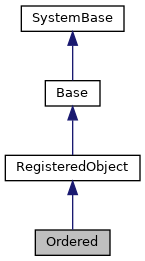This class provides cluster analysis for a set of ordered objects. More...


Static Public Member Functions | |
| _.Library.Status | ordered (_.Library.Integer m, key, _.Library.Integer nc, q) |
| This method clusters one-dimensional ordered data into nc clusters. More... | |
| _.Library.Double | pg (_.Library.Integer m, _.Library.Integer nc, key, q, _.Library.Status sc) |
| This method calculates Pearson-Gamma correlation coefficent for clustering obtained by method. More... | |
| print (_.Library.Integer m, _.Library.Integer nc, key, q) | |
| This method prints verbose information about clustering results obtained by method. More... | |
Additional Inherited Members | |
 Public Member Functions inherited from RegisteredObject Public Member Functions inherited from RegisteredObject | |
| _.Library.Status | OnAddToSaveSet (_.Library.Integer depth, _.Library.Integer insert, _.Library.Integer callcount) |
| This callback method is invoked when the current object is added to the SaveSet,. More... | |
| _.Library.Status | OnClose () |
| This callback method is invoked by the <METHOD>Close</METHOD> method to. More... | |
| _.Library.Status | OnConstructClone (_.Library.RegisteredObject object, _.Library.Boolean deep, _.Library.String cloned) |
| This callback method is invoked by the <METHOD>ConstructClone</METHOD> method to. More... | |
| _.Library.Status | OnNew () |
| This callback method is invoked by the <METHOD>New</METHOD> method to. More... | |
| _.Library.Status | OnValidateObject () |
| This callback method is invoked by the <METHOD>ValidateObject</METHOD> method to. More... | |
 Static Public Attributes inherited from RegisteredObject Static Public Attributes inherited from RegisteredObject | |
| CAPTION = None | |
| Optional name used by the Form Wizard for a class when generating forms. More... | |
| JAVATYPE = None | |
| The Java type to be used when exported. | |
| PROPERTYVALIDATION = None | |
| This parameter controls the default validation behavior for the object. More... | |
This class provides cluster analysis for a set of ordered objects.
One can also think of it as one-dimensional cluster analysis.
Methods in this class divide the set into a given number of subsets trying to optimize a given target value. Target value can be:
|
static |
This method clusters one-dimensional ordered data into nc clusters.
The algorithm is described in:
Helmuth Spaeth,
Cluster Analysis Algorithms for Data Reduction and Classification of Objects,
Ellis Horwood, 1980, page 63, QA278 S6813.
Input data is given as a multidimensional array m. The top value of m must be the number of data objects in the array. The array contains numerical values m(1:m) for each object.
In most cases key should be an empty string. In such a case all calculations are done in memory. If key has value then this value is used as a subscript ot a process private globals that hold intermediate results. This will make the calculations significantly slower but will allow to deal with larger amount of objects.
The result is returned in teh form of multi-dimensional array q. q(1:nc,1:nc), describes the clusters of data. The last row of q stores the first element in each cluster. Thus cluster 1 contains data items q(nc,1) through q(nc,2)-1. Other information is contained in previous rows. In particular, in row J, columns 1 through J, there is similar information about a partition involving J clusters.
|
static |
This method calculates Pearson-Gamma correlation coefficent for clustering obtained by method.
<METHOD>ordered</METHOD>. Input data is taken in the same way as by <METHOD>ordered</METHOD> method.
For more information about Pearson-Gamma correlation coefficent see <CLASS>PearsonGamma</CLASS>
|
static |
This method prints verbose information about clustering results obtained by method.
<METHOD>ordered</METHOD>. Input data is taken in the same way as by <METHOD>ordered</METHOD> method.